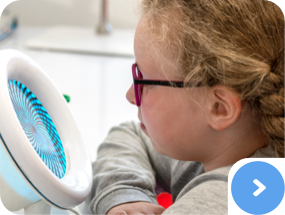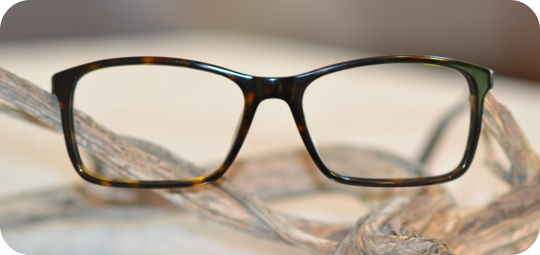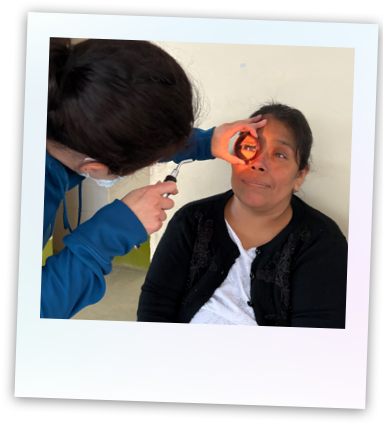Vision is a crucial part of the learning process. In fact, research indicates that approximately 80% of learning is visual. Regardless of your child’s age, they rely on their eyesight to help them reach developmental milestones, keep up with peers academically, and even pick up on social cues.
However, the increase in myopia or nearsightedness over recent years may be threatening our children’s education. As an optometrist with a master’s degree in public health and a parent, I think it’s absolutely vital that every parent understands the current myopia epidemic, and how something as simple as digital screens could impact their child’s vision.
What is Myopia?
Myopia is the medical term for nearsightedness, which prevents people from seeing distant objects clearly.
In a “normal” or non-myopic eye, the cornea bends light so it focuses at a point directly on the retina. In a myopic eye, the eyeball is too long compared to the curvature of the cornea. As a result, the light bends and focuses at a point in front of the retina, which causes anything past a certain distance to appear blurry.
Myopia isn’t exclusive to children. Plenty of adults have myopia. The difference is that childhood myopia tends to get worse as the child ages. Your child’s eyes grow with them, which means light focuses at a point further and further away as they get older.
Is Myopia Curable?
As of 2019, there’s no real way to reverse myopia with the exception of laser eye surgery, which isn’t an option for kids. Myopia can be managed or corrected in children and adults with contact lenses and glasses. Kids can (and should) also undergo myopia control, which helps slow the progression of myopia until your child’s eyes stop growing.
Evidence of an Epidemic

Myopia has become increasingly common among children in the last few decades. This trend is well documented and has been confirmed by the World Health Organization, the International Myopia Institute, and the Canadian Association of Optometrists.
One study compared the prevalence of myopia in the general population from 1971-1972 to 1999-2004. Back in the 70s, the study found 25% of people had myopia. That number jumped to 42% by 2004, indicating 168% growth in myopia prevalence over 32 years.
What’s more unsettling is that researchers estimate that half of the global population will be nearsighted by 2050.
What’s Causing the Epidemic?
There’s some discussion as to why myopia is becoming so common, particularly among young kids. Aside from genetic factors, the biggest catalyst seems to be our increased use of digital devices and screens like phones, tablets, and laptops. Since smartphones first became available in 2007, myopia prevalence has spiked even further.
Digital displays emit blue light, which can negatively affect your lifestyle and eye health. However, it’s not the light or even the screens themselves that increase the risk of myopia. It’s actually the way we use them.
We hold most mobile devices about 20 cm from our faces when we use them. Our eyes were not designed to focus on such a near point for extended periods of time. Some scientists believe that this increasing demand for extreme near work fuels the increase in myopia among kids.
To be clear, near work like reading is not likely to trigger myopia. Most of us hold reading materials between 45 and 50 cm away from our faces; twice as far as we hold a smartphone. This unusual nearness seems to be the primary culprit.

Mitigating and Aggravating Factors
Your child’s environment and daily activities have a significant impact on the way their eyes develop and progress. The same principle applies to myopia development and progression.
For example, the risk of developing myopia increases when you introduce mobile devices. On the other hand, studies show that children who spend time playing outside are far less likely to develop myopia.
Limiting Screen Time is Important
Not all screen time is necessarily bad. Digital devices give us access to a world of knowledge wherever we go. However, it’s absolutely crucial that parents limit a child’s recreational screen time. As a parent, I completely understand how tempting it is to just set your child up with games on your smartphone to buy yourself a little bit of a break. But that habit has the potential to do lasting damage to your child’s vision.
I typically don’t recommend allowing kids under the age of 24 months to play with mobile devices. For children between 2 and 5 years old, an hour is the absolute maximum screen time you should allow, and it’s best to limit their options to educational and high-quality games and activities. For older children, you’ll have to evaluate screen time limits on a case-by-case basis. But it never hurts to be conservative with your limit.
As your child grows up, they will need to rely on digital devices for socialization, school, and work. Limiting their time while they’re young can help preserve their vision and maybe prevent them from developing a life-long dependency on mobile devices for fun and comfort.
Download a Screentime Monitor
There are plenty of tools to make sure your child doesn’t exceed a specific amount of screen time. Today’s Parent has put together a good list of apps that will prevent kids from sneaking in some extra gaming or social media.
Set Specific Boundaries for Screen Use
Some parents restrict screen use to specific times of the day and areas of the house, for example, after dinner, and in the living room. Personally, I think it’s wise to make a “no devices in kids’ bedrooms or bathrooms” rule.
First of all, if you can see your children playing on their devices, you’re more aware of how long they’ve used them that day. Secondly, limiting devices to public areas of your home can help eliminate some of the safety concerns associated with kids and the internet.
Balance Screen Time With Outdoor Time
Playing outside shouldn’t be a chore. But it’s important enough that it’s worth mandating time outside for your child every day. You could say that for every half hour of screen time, your kids need to spend an hour outside, including recess and lunchtimes.
Of course, you may have to make some exceptions during the harsh Alberta winters, but even spending 2 hours outside a day 11 months of the year could make a huge difference in your child’s eye health.

Embrace Technology but Use Caution
Technology and innovation is a great thing; optometrists rely on it to provide the best possible care. But remember, we don’t always know what kind of impact new technology will have on our health until research becomes available. Be careful to use new tech sparingly until you know more about it, and of course, keep an eye on your child’s visual health with annual eye exams.

























